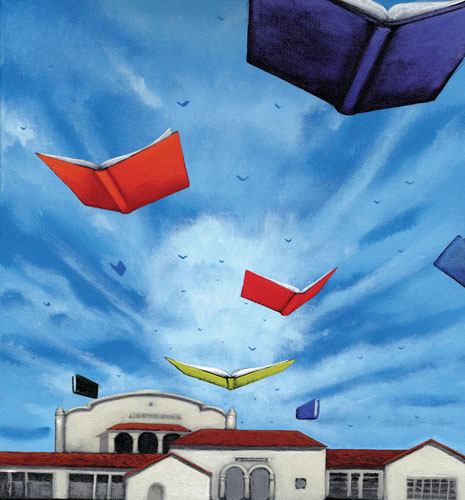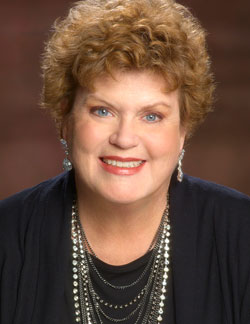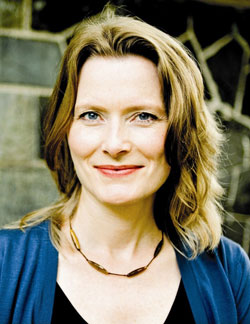Las Vegas book fest’s keynote speakers Harris, Egan embrace literary experimentation
• Book festival events, activities
They write in different genres - right now, anyway - but Charlaine Harris and Jennifer Egan share an inclination toward literary experimentation.
For Harris, author of the best-selling Sookie Stackhouse Southern vampire mystery series - the inspiration for the hit HBO series "True Blood" - it's writing her first graphic novel trilogy.
For Egan, it's employing unusual literary structures - including Twitter tweets and PowerPoint - in the service of telling stories.
So, consider it a bit of unexpected synchronicity that Harris and Egan will be the keynote speakers at this year's Vegas Valley Book Festival.
This year's event - which runs from Thursday through Saturday - marks the festival's 11th anniversary. It will include attractions of interest to adult, child and young adult readers; writers and potential writers; poets and poetry lovers; and fans and creators of comics and graphic novels.
Scheduled activities - all of which are free and open to the public - will include author talks and presentations, storytelling sessions, panel discussions, and music and theatrical performances.
Last year's event drew about 12,000 people, and this year's guests "are going to be blown away by the lineup of over 100 authors coming to town," says Danielle Milam, festival co-chair and development director of the Las Vegas-Clark County Library District.
"It's really about celebrating all of the forms of the word, and all the people that are working in that," Milam adds. "You can just let your imagination run wild."
Here's a closer look at the two keynote speakers.
CHARLAINE HARRIS: AUTHOR'S 13TH SOOKIE BOOK DUE OUT IN 2013
Harris kicks off the festival Thursday with a 7 p.m. keynote address at the Clark County Library, 1401 E. Flamingo Road. The rich mythology she has created in her Sookie Stackhouse novels - including vampires, were-creatures, telepaths, shapeshifters, fairies and witches - is so sprawling that one imagines her study to be packed with maps, charts and floor-to-ceiling Post-it notes to keep track of it all.
Hearing that guess, Harris laughs and admits, "Well, I certainly have had my share of Post-it notes."
Actually, Harris says she keeps track of her series with the help of a "continuity editor" whose job is to ensure that "people's cars were the same color in every book and that people were the same age and had the same hair color - all those little things you tend to forget because my mythology is so huge and my cast of characters got so large."
Readers keep tabs on such things? "You have no idea," Harris answers with another laugh.
"My point of view was always, 'Oh, my gosh, who cares?' But people do. They really do."
Consider it a compliment, a sign of how invested in her stories readers have become. But here's something that's as bizarre as anything Harris has dreamed up: She had a difficult time getting the first Sookie novel published.
"There wasn't (the genre) urban fantasy when I started writing the Sookie series," Harris explains. "It was 15 years ago, and that field did not exist. The only person doing anything remotely like that was Laurell K. Hamilton (author of the Anita Blake series).
"So it was an extremely hard sell. A lot of people looked at it and rejected it in very unflattering terms."
But, when "Dead Until Dark" finally was published in 2001, it was a hit. Eleven more books followed, and Harris' 13th and final Sookie novel, "Dead Ever After," is scheduled to hit the shelves in 2013.
Even before Sookie and company, Harris was writing mysteries and crime novels with a less-supernatural bent. What prompted her literary move into the supernatural?
"I just think it's interesting to try to make yourself a better writer by writing about something you haven't done before in a way you haven't done it before," she says.
Also, "I wanted to write about social issues, and I thought it would be interesting to frame it in a different way so that it wasn't preachy," Harris says. "And, I thought it would be really interesting to write about a woman who was dating a vampire and what would be happening to her socially, what would be happening to her personally, what would be happening to her in the world if she did such a stupid thing, and why would she do that. And everything just kind of evolved."
Sookie resonates with readers because of "the real, everyday human problems" she faces, Harris says.
"She has to pay her property taxes, and she can't afford to replace the curtains, and she's worried about all sorts of financial issues. She doesn't want to go to the hospital because her health insurance won't cover some things, and she has a list of things like that that weigh on her.
"Then, she's got the added pressure of trying to date someone who isn't the same species, and the difficulties of that are kind of overwhelming."
Readers are bracing themselves for the final story in the Sookie Stackhouse series, and Harris confirms that the last book truly will be the last book.
"I've told her story," she says. "It wouldn't be fair to my readers to keep going on when I've said what I set out to say."
Harris' current projects include a new three-book series ("Midnight Pawn") and writing her first graphic novel trilogy, "Cemetery Girl," with writer Christopher Golden.
Writing for comics is "completely different," she says. "It's a huge learning curve for me. I'm an old dog learning new tricks."
And, of course, the characters Harris created can be seen on the HBO series. Harris says she's fine with the dramatic - and sometimes truly bizarre - ways in which the TV series differs from her own stories.
"I like to be surprised, and God knows I am," she says, laughing. "It's always interesting to see what they're doing.
"I know a lot of writers on the show, I know the cast, I know some of the crew, and I'm just always cheering for their success."
JENNIFER EGAN: PULIZER PRIZE WINNER FOUND OF 'EXPERIMENTS'
Egan doesn't just tell a story. Rather, like a kid with a glob of Silly Putty, Egan can take a story and then squish and stretch it into forms that readers never expected to see.
A serialized sci-fi/spy story told in Twitter tweets. A book chapter that takes the form of a PowerPoint presentation. A verbal iteration of a '70s rock 'n' roll concept album.
All sound bizarre at first but, in Egan's hands, end up not just working, but working in ways that seem both radical and completely natural.
She will be Saturday's keynote speaker at the Vegas Valley Book Festival. Her presentation will begin at 3:30 p.m. in the auditorium of the Historic Fifth Street School, 401 S. Fourth St.
Egan - who also writes news features and commentaries for The New York Times Magazine and other publications - was awarded the 2011 Pulitzer Prize in fiction for "A Visit from the Goon Squad," which revolves around several characters whose lives are loosely connected by rock music.
It's an interesting work on several counts. For one thing, some reviewers weren't even able to agree on whether it's a novel or a short story collection.
The author understands the confusion. Egan - who says she "grew up on The Who and 'Tommy' and 'Quadrophenia' and David Bowie's Ziggy Stardust" - says she was halfway into writing the book when she realized that she was creating something more along the lines of a rock 'n' roll concept album.
"It's a big story told in small parts, and they sound totally different from each other," she explains.
And, just like a concept album, "that's what a novel - a good novel, anyway - is like," Egan says, moving in each selection "from fast to slow, slow to fast, funny to earnest."
Egan admits, too, that it took her a while to realize the degree to which music pervades the novel.
"For instance, when we publicized it, we didn't at all, as far as I know, reach out to the music press. In retrospect, that seems really strange, but I think I and my publisher didn't quite see the book that way."
But it worked out well: When the music press, and music fans, discovered her book by word-of-mouth, it generated a second wave of both sales and critical interest.
And, if nothing else, Egan says writing "A Visit From the Goon Squad" sated her longtime hunger to "learn about the music business."
One chapter of the book takes the form of a PowerPoint presentation written by one of its characters. It - as well as "Black Box," Egan's serialized futuristic spy story told entirely in 140-character Twitter tweets - demonstrates Egan's willingness to experiment with telling stories in unconventional ways.
"It's not easy to pull off those kind of experiments," she says. "I've had many that haven't worked."
The trick isn't "finding a way to make a story work in an unusual form, because if that's all you're doing, it probably won't work," she says. "The really hard part is finding a story that can be told only in that way, and that can be very hard. It takes a lot of patience."
That PowerPoint chapter, for instance, "would have been a complete nonentity if it had been written conventionally, because it's actually a very sentimental chapter, a sweet family story in which little actually happens," she says.
But PowerPoint is, by its very nature, "atomized. There's no continuity, no relationship between one moment and the next. There's no in-between - you're here, then you're there," she says. "That doesn't work so well for fiction, but if you have a chapter in which very little happens, you can sort of make it work."
What also makes it work is that PowerPoint typically is experienced "in the corporate realm," Egan says, "and I think it's that cold, corporate feeling that lets me get away with the open sentimentality of the chapter."
Similarly, Egan says her Twitter story about a futuristic female spy - tweets of which were released over a period of nine days on The New Yorker's Twitter feed - would have been a cliched James Bondian tale if she hadn't taken advantage of the quick-hit nature of Twitter tweets to craft the story as a series of "mental dispatches" by the spy.
Whatever the medium, Egan says the challenge lies in "finding content that will thrive in these media, at least for me.
"I find that a story - any story - suggests its form, and if you try to push too hard against that, you just end up with something mediocre."
Contact reporter John Przybys at jprzybys@ reviewjournal.com or 702-383-0280.



















